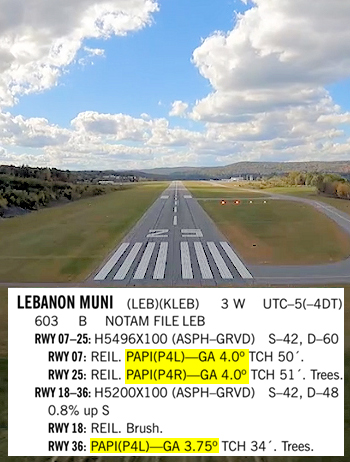Subscriber question:
"In a light airplane, should you fly the approach on or above the PAPI glideslope? I just did a flight review and the instructor told me not to fly two red, two white on the PAPI, but three white, one red." — Tim P.
Jeff:
 “Your instructor has a point that a typical light airplane can use a steeper approach than flying centered on a visual glideslope indicator. (That’s a VGSI, a.k.a. a VASI or PAPI.) Flying a steeper approach offers a better chance of reaching the runway if you have a power problem on short final. It’s also true that consistent approaches can yield better, safer landings. However, the solution of three-white, one-red probably doesn’t do much for you. Here’s why:
“Your instructor has a point that a typical light airplane can use a steeper approach than flying centered on a visual glideslope indicator. (That’s a VGSI, a.k.a. a VASI or PAPI.) Flying a steeper approach offers a better chance of reaching the runway if you have a power problem on short final. It’s also true that consistent approaches can yield better, safer landings. However, the solution of three-white, one-red probably doesn’t do much for you. Here’s why:
VGSIs offer a 3-degree glide path—if terrain and obstacles permit. That’s because ILS and LPV instrument approaches also use 3 degrees, if possible. Three degrees is pretty shallow. If you turned base-to-final at 500 feet AGL and were centered on a 3-degree glide path, you’d be about 1.5 miles from the runway—way beyond glide range for a typical piston single.
Most VASIs only offer one glide path (some offer two). A PAPI offers three. However, for VGSIs with more than one glidepath, the difference between glidepaths is just 0.2-0.3 degrees. Flying one versus the other is almost inconsequential.
Browse the Chart Supplement and you’ll see that some VGSIs are much steeper than 3 degrees. Terrain could necessitate angles of 4.5 degrees or more. So always flying centered on the VGSI isn’t as consistent as most people think. Most VGSIs keep you clear of obstacles within 3.4-4.0 miles from the airport and 10 degrees left or right of the centerline. Exceptions to this will also appear in the Chart Supplement.
Given that most light, GA airplanes can handle final approach angles of 6 degrees, or steeper, if needed, the real takeaway here is simply remaining at or above any VGSI. That’s actually required at towered airports per 14 CFR 91.129 (e)(3). It says that when landing on a runway with a VGSI each pilot, ‘must maintain an altitude at or above the glide path until a lower altitude is necessary for a safe landing.’
How high above depends on your comfort level with reaching the airport in the event of a last-minute engine problem versus your ability to land and stop within the desired distance. And you get to decide when it’s necessary to descend for that safe landing.”
Do you normally fly centered on the VASI or PAPI to the runway if one is available?

